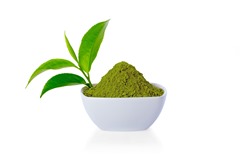Breast cancer is the most commonly diagnosed cancer in women. The 5-year cure rate with conventional medicine has become quite good, but even so, at least 40,000 women die each year. While most of breast cancer has no known cause, there are some modifiable risk factors that include, alcohol intake, exercise, weight and breast density, as assessed on a mammogram. It has been reported that there is a 2% higher risk of breast cancer associated with every 1% increase in mammographic density.
 Green tea extract is one potential therapy for reducing breast density in those women who show significant breast density on the mammogram.
Green tea extract is one potential therapy for reducing breast density in those women who show significant breast density on the mammogram.
In the current study, 1,075 healthy postmenopausal women between the ages of 50 and 70 had heterogeneously dense or extremely dense breast tissue on the screening mammogram. These women were randomized to receive either green tea extract (538 women) or placebo (537 women). In the end, 462 women in the green tea group were analyzed. A decaffeinated green tea extract capsule containing 328.8 mg of total catechins, 210.7 mg epigallocatechin-3-gallate (EGCG), and less than 4 mg caffeine was taken at a dose of 4 capsules per day for 12 months. That’s a total of 1,315 mg catechins, 843 mg EGCG and less than 16 mg caffeine per day.
Each woman had a mammogram at baseline and after 12 months to assess mammogram breast density. Numerous other parameters were done including health questionnaires, some genotyping, select blood tests (plasma insulin-like growth factor 1, IGF binding protein, estrone, estradiol, androstenedione, sex hormone-binding globulin, urinary estrogen metabolites and plasma F2-isoprostanes.
Daily green tea capsules did not significantly reduce percentage mammographic density or absolute mammographic density compared to placebo after adjusting for age and body mass index at 12 months. However, for one age group, the women aged 50 to 55, the 12 months of green tea extract did significantly reduce the percentage of mammographic density, resulting in a 4.4% decrease compared to placebo. Other factors, such as body mass index, years since menopause, alcohol, pregnancy history, and tea drinking showed no effect on percentage mammographic density with green tea intake. This 4.4% decrease in density in women aged 50-55 who consumed green tea extract for 1 year, could potentially translate to an 8.8% reduction in breast cancer risk. Turns out, a study on tamoxifen (used as an estrogen receptor blocker in breast cancer management), had a similar 4.4% reduction in breast density over 18 months5 This same study reported that after 54 months of treatment, tamoxifen reduced MD by 13.4% in women age 45 or younger; while those older than 55 had a 1.1% decrease in MD over the same period of time.
In a 2007 study, women with greater than 75% mammographic density had an increased risk of breast cancer compared to women with less than 10% mammographic density, and the risk was especially greater for women younger than 56 years. For these women younger than 56 years old, 26% of the breast cancer cases and 50% of cancers detected within 12 months of a normal screening mammogram were thought to be due to a mammographic density of 50% or more.
Commentary: Providers and women should consider strategies to reduce breast density, as a part of reducing the risk of breast cancer, and for green tea extract, it is particularly important for women ages 50 to 55 who have heterogeneously dense or extremely dense breasts.
Reference: Samavat H, Ursin G, Emory TH, et al. A randomized controlled trial of green tea extract supplementation and mammographic density in postmenopausal women at increased risk of breast cancer. Cancer Prev Res (Phila). 2017;10(12):710-718.

